Text
Varlamov, I., 2019. Реновация Панельного Дома В Германии. [online] Varlamov.ru. Available at: <https://varlamov.ru/3733528.html> [Accessed 29 April 2020].
This entry is a blog post by Ilia Varlamov, a Russian activist whose practice is mainly focused on architecture. The post is dedicated to Moscow’s renovation program, which aims on demolishing old khruschyovkas and building new blocks of flats as a replacement. In it, I. Varlamov argues that demolition may not be the most efficient choice, and compares it to the renovation program in Germany, which consists of renewing the facades, installing elevators and changing the windows from old to new ones.
Since the renovation program is also a significant aspect of Moscow nowadays, I am also interested in researching this process further. How will building new apartments influence Moscow? Will the overall level of satisfaction rise, and how will the demolition of khruschyovkas reflect on the public’s view of them?
Keywords: renovation, Russian architecture, critique
0 notes
Text
Bylinkin, N. and Riabushin, A., 1985. Sovremennaia Sovetskaia Arkhitektura. Moskva: Stroĭizdat.
Contemporary Soviet Architecture is a 1985 book describing the development of Soviet architecture in a span of 30 years (1955-1980).
“В целом для современного периода развития советской архитектуры характерно создание весьма значительных градостроительных ансамблей во многих городах страны. <...> Более широко монументальное искусство вошло в архитектуру жилых микрорайонов и отдельных общественных зданий. Сила ее воспитательного воздействия велика, она действует постоянно, поскольку вся жизнь и деятельность человека протекает в архитектурной среде. Вместе с природой и элементами предметного мира (дизайн) архитектура постоянно объемлет человека, воздействует на него не только визуально, подобно изобразительным искусствам, но и в процессе непрерывного ее потребления в качестве материального блага.” (Bylinkin, Ryabushkin, 1985)
I was especially interested in the quote above. It presents Soviet architecture as part of the socialist propaganda, which there is no avoiding. Describing the feeling of being surrounded by Soviet symbolism as “endless consuming” can give the reader an understanding of how forceful the propaganda was.
Keywords: Soviet architecture, propaganda
0 notes
Text
Fabuš, P., 2010. Divus | Tomáš Džadoň: Will To Tradition And Images Of Nostalgia. [online] Divus.cc. Available at: <http://divus.cc/london/en/article/tomas-dzadon-vule-k-tradici-a-obrazy-nostalgie?printLayout=true> [Accessed 26 April 2020].
The essay above discusses the phenomenon of post-Soviet nostalgia. It specifically focuses on panelák buildings as symbols of the trend. The author uses Tomas Džadon as an example of discussing the phenomenon in a variety of ways. The essay also goes quite in-depth describing the origins of the term nostalgia.
"Our contemporary society often feels disjointed, lacking in a definite ideological direction, yet here we are surrounded by a rich heritage of reminders, artifacts, and ideas inherited from our predecessors."
"Tomas Džadoň candidly views the past as a permanent presence, and his work constantly presents this to the viewer"
"Nostalgia nowadays is everywhere. It is one of the driving forces behind tourism, and its emotional appeal has been exploited by advertising gurus. It not only affects older generations; indeed nostalgia and “retro” are well known to teenagers experiencing rapid cultural shifts. Nostalgia takes its toll mostly where cultural or national identity form. Evident everywhere from cinema to literature, it idealizes not only the political transformations of the past twenty years in Eastern Europe, but also Western imperialist history"
"The panelák, an ever-present reminder of communism, has become part of Czech and Slovak culture. For younger and middle-aged generations who grew up or still live in the blocks, the uniformity of living spaces therein symbolizes an important formative experience"
To me, this article was helpful because it offers potential food for thought for my essay. What exactly is the formative experience that people go through, growing up in a panelák? Why is it that the feeling of being disjointed as a society comes up so often?
Keywords: nostalgia, essay, politics, Former Eastern Bloc
0 notes
Text
Dolgopolova, M., 2018. Панельные Викторины И Балконная Хтонь: 10 Пабликов О Типичных Городских Пространствах России. [online] Strelka Mag. Available at: <https://strelkamag.com/ru/article/10vkontakte> [Accessed 26 April 2020].
This article by Strelka offers a list of VKontakte groups which explore the city spaces in Russia.
I decided to keep this link as an entry, because it may provide me with helpful visual materials for my essay, if I were to take the topic of Russian architecture or Russian cities. As well, this article is part of a phenomenon surrounding Russians' interest towards panel buildings, ruins and messy streets / balconies. Why is it that this topic is so prevalent? Is it a case of 'so bad it's good'? Is it a cry for help? Is it a red flag?
Keywords: Russian cities, destruction, neglect
0 notes
Text
DŽADON, G. Folk architecture monument / Pamätník ľudovej architektúry 2007 [Online] Available at: http://www.tomasdzadon.com/block.html
"The mistake is made. The socialist urban projects destroyed the marvellous countryside. I grew up in such an utopic project. I was lucky to be able to watch the Tatra mountains from my window. Finally that blocks were not so bad.
The proportion changed. From family houses to 13-floor blocks. From houses built by their owners to flats built by the regime" (Džadon, 2007)
The quote above is by Tomas Džadon. It served as a description for one of his projects, namely Folk Architecture Monument. Džadon points out the difference of proportion between a country house and a block of flats, which is interesting to explore. How does the difference in proportion change the way its inhabitant feels?
It is also interesting to observe Džadon's personal reaction to the buildings in question. The choice of words makes me think that he may feel resentful towards the panel districts, and perhaps find them invasive. However, it is also notable that they are still part of many of his works.
Keywords: cultural heritage, personal connections to architecture, Former Eastern Bloc
0 notes
Text
youtube
Technical Aesthetic. Leningrad - St Petersburg. 2018. [Film]. Mavrin, L. Russia: Octopus Studio.
The documentary focuses on Soviet design and the challenges a Soviet designer faced in his work. The film is also structured in a chronological order: it starts with a short overview of the bolsheviks overthrowing the government, and ends with modern-day Russia. The designers of those eras serve as interviewees and narrators, talking about their projects and the situation around them at the time.
I was especially interested in the very end of the documentary, where contemporary Russian designers commented on the situation in the country (in regards to art and design) and shared their opinions about what is next. One of the designers stated that in his opinion, which he called unpopular, there is no need to follow Soviet design as a goal, because although it was somewhat of a breakthrough for its time, it was very time- and energy-consuming, which is not fitting for the regimen of modern-day Russia. It makes me wonder how will Russian design evolve in the future.
Keywords: Soviet culture, Russian culture, Russian design, reevaluation
0 notes
Text
Evans, H., 2017. The Essence Of Skin: An Interview With Evelyn Bencicova. [online] Scene360. Available at: https://scene360.com/art/104588/evelyn-bencicova-interview/ [Accessed 23 April 2020]
The article above is another interview with Evelyn Bencicova, where she discusses her practice, sources of inspiration, and, specifically, her project titled School of Life, which showcases the models posing in a seemingly abandoned building. The stacks of chairs, massive shelves and wall colour are very reminiscent of the Soviet times, and, combined with the models’ restricted and rather static poses create the atmosphere of strict structure, but at the same time, nostalgia.




“The inspiration comes from an empty chemistry school in Slovakia that is being turned into new creative center. This project deals with nostalgia as it is connected with the destruction of architectural remains, which are a part of our cultural heritage, serving as a recreation of an already-vanishing past. I was guided by the space itself, and I created the first (but also maybe the last) representation of its atmosphere before its reconstruction.” (Bencicova, 2017)
As seen from the interview outtake above, Bencicova approaches the Soviet heritage of Slovakia as
This interview was important for me to discover
Keywords: nostalgia, Eastern bloc, national heritage, photography
0 notes
Text
Van Dijk, T., 2019. Fictions Based On Truth: An Interview With Evelyn Bencicova. [online] Gupmagazine. Available at: http://www.gupmagazine.com/articles/fictions-based-on-truth-an-interview-with-evelyn-bencicova [Accessed 23 April 2020]
Fictions Based On Truth is an interview with Evelyn Bencicova. While the interview touched upon a variety of topics, the name of the article seems to stem from the part where she was asked about the Soviet influence in her work:
“Asymptote uses architectonic sites that are authentic to the era of socialism. Places, former symbols of power and greatness, elevated in order to make the person feel small. Today they stand still, stripped of essential purpose, abandoned or forgotten like a gravestones of their former glory. Asymptote merges past and present, by reflecting on one at the time of the other.
At the basis of the project lies a historical foundation that collaborates with a fictional scenario to blur the lines between reality and memory. Like a fiction based on truth. Authentic testimonies and archive materials are reinterpreted by contemporary digital language. The goal is not only to reflect on the past, but most importantly to address the current state of society and its values.
All body form in the project is folded within the space to shape a coherent geometrical composition, a symbol of the regime itself. People create a pattern. Each one is stripped of their own individuality to become a unified form, creating a society where every difference is an anomaly in the system.” (Bencicova, 2019)
I found the interview important because of Bencicova's approach to her country's past. She acknowledges the flaws of the Soviet Union and reflects on the influence they had on Slovakia through the means of photography. Her works are a combination of contemporary fashion and Soviet architecture, and it is interesting to see how through such poetic means Bencicova is able to make light of political and social issues.
Keywords: Eastern bloc, Soviet past, nostalgia, re-evaluation
0 notes
Text





Bencicova, E. (not dated) Evelyn Bencicova Portfolio [online]
Available at: http://evelynbencicova.com [Accessed 23 April 2020]
Evelyn Bencicova is a Slovakian photographer. The most prevalent aspects of her work are the large amounts of space, as well as the attention to light, which can be seen in the shots above. A common place for E. Bencicova’s photoshoots are modernist buildings; the models’ clothing often reflects the colour palette of their surroundings, which makes them part of the scene, rather than the main focus, standing out against its background. One could also interpret the large amounts of space as a hint on loneliness, as the models are often alone in the shot, positioned in the centre. The grandeur with which some modernist buildings were created is also reflected in Bencicova’s work, where the building is much larger, almost more intimidating, than the person in the shot.
It was interesting for me to discover Evelyn Bencicova’s works because of how familiar the places of the photoshoots seem, even though I and the photographer are situated in different countries. The similarities in architecture can still be found in the entirety of the Eastern bloc, which creates a feeling that is almost déjà vu; although one has never been to that particular building before, they may feel like they recognize the familiar structures, the ones that surround people of the Eastern bloc from childhood (even though they may have never witnessed the Soviet Union).
Keywords: nostalgia, Eastern bloc, Soviet architecture, national heritage, déjà vu
0 notes
Text


Bondarenko, A., Vlasov, L., Lifschitz, M., Milovidov, B. and Molchanova, O., 1960. Краткая Энциклопедия Домашнего Хозяйства. Moscow: Государственное научное издательство "Советская энциклопедия"
edition 1:
https://docviewer.yandex.ru/view/330049024/?*=wryNuBItXFnqgth2OwE43Zrcd5Z7InVybCI6InlhLWRpc2stcHVibGljOi8vaEtNREpnTXlPVTRJTjJpSnBjakVRVi9qUStUejBrdXR3SmtTYUVVR3B1ND0iLCJ0aXRsZSI6IktyYXRrYWlhLWVudGNpY2xvcGVkaWlhLWRvbWFzaG5lZ28taG96aWFpc3R2YS1Ub20tMS1BLU4tMTk2MC5kanZ1Iiwibm9pZnJhbWUiOmZhbHNlLCJ1aWQiOiIzMzAwNDkwMjQiLCJ0cyI6MTU4NzU2NTIxODU2OCwieXUiOiIyMjA2NDM5ODAxNTU3NTE5NjE4In0%3D
edition 2:
https://docviewer.yandex.ru/view/330049024/?*=cXsCD65lw1D0bUoh3x7zRDOXxzh7InVybCI6InlhLWRpc2stcHVibGljOi8vWFJOZVJQNzJjdE04VkpDeGNIYkVIbi92UDlTdk1NVjB2em9kS1RhN21yVT0iLCJ0aXRsZSI6IktyYXRrYWlhLWVudGNpY2xvcGVkaWlhLWRvbWFzaG5lZ28taG96aWFpc3R2YS1Ub20tMi1PLUlBLTE5NjAuZGp2dSIsIm5vaWZyYW1lIjpmYWxzZSwidWlkIjoiMzMwMDQ5MDI0IiwidHMiOjE1ODc1NjUyMzk3NjcsInl1IjoiMjIwNjQzOTgwMTU1NzUxOTYxOCJ9
Brief Encyclopedia of Housekeeping is a 2-tome Soviet book, which consists completely of descriptions of Soviet furniture, clothing / sewing patterns, various devices one could own at home (refrigerators, lamps, etc) -- essentially, everything that a Soviet person was expected to own or do. The Encyclopedia also includes a variety of rules and regulations, such as “home clothing must be pristine and comfortable for work” (tome 1, p. ) It also includes pictures of typical Soviet flats (or what they were expected to be).
This encyclopedia was interesting for me to discover because it provides a lot of material about the life of a Soviet person; it differs greatly from modern-day magazines or books, and is essentially both a dictionary and an advertising campaign, promoting furniture, lamps or stoves. What is also curious to discover is the
Keywords: Soviet culture
0 notes
Text
Erofeev, N., 2015. Эстетика Советской Жилой Архитектуры. [online] Архи Ру. Available at: <https://archi.ru/russia/64030/estetika-sovetskoi-zhiloi-arkhitektury> [Accessed 22 April 2020].
This article offers a walkthrough through the history of prefab architecture in Russia. It also discusses people's opinions towards these districts and, all in all, not only offers historical information, but also explores this era's context.
The work offers quite extensive information about the development process of prefab architecture, which was interesting and useful to get into.
Keywords: prefab architecture, Soviet architecture, nostalgia, Russian aesthetic
0 notes
Text

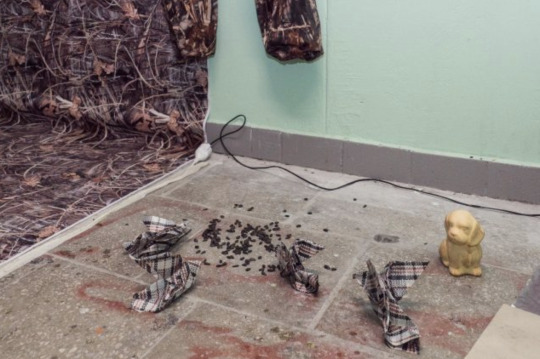
CHERNYAVSKAYA, K. Pigeons 2018 [Online] Available at:
https://knife.media/story/nasrano/
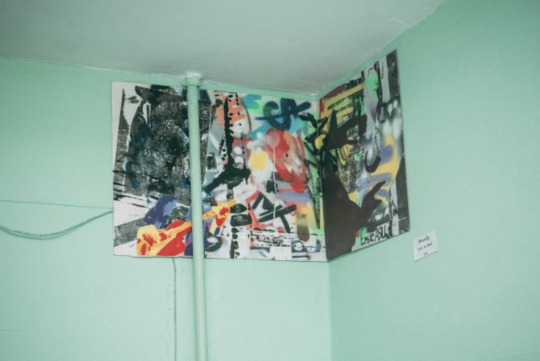
ARU, E. In a corner behind the pipe 2018 [Online] Available at: https://knife.media/story/nasrano/
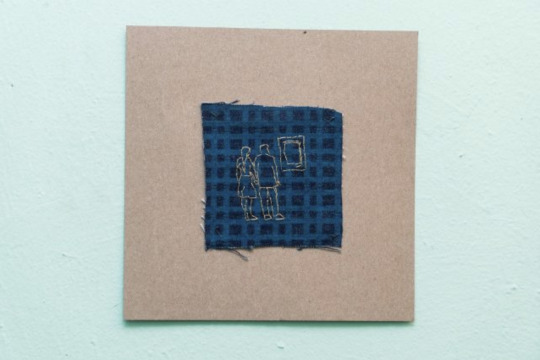
SUVOROVA, P. About happiness 2018 [Online] Available at: https://knife.media/story/nasrano/
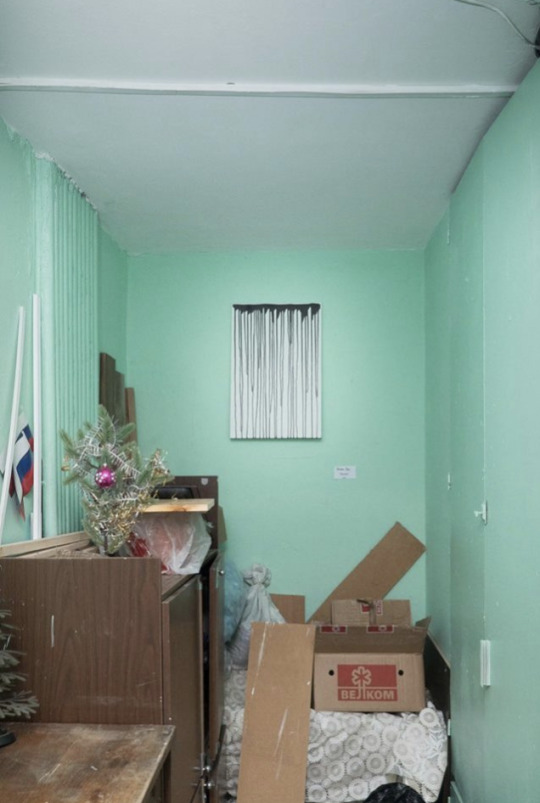
ARU, E. Dripping 2018 [Online] Available at:
https://knife.media/story/nasrano/

TIMONOV, A. Chandelier 2018 [Online] Available at:
https://knife.media/story/nasrano/

SCHPREISER, M. Untitled 2018 [Online] Available at:
https://knife.media/story/nasrano/
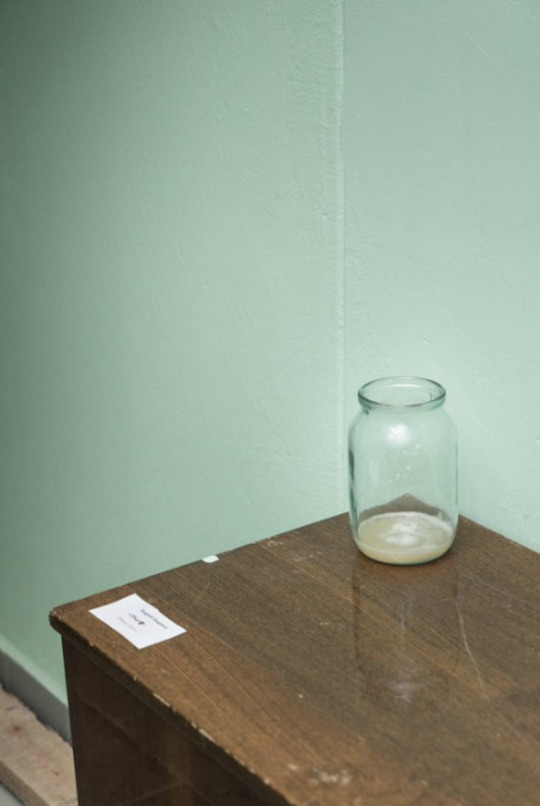
ANDREEV, A. Dorm(?) 2018 [Online] Available at:
https://knife.media/story/nasrano/

SELIVANOV, Y. Window 2018 [Online] Available at:
https://knife.media/story/nasrano/
Nizhnik, A., 2019. В Подъезде В Чертанове Организовали Выставку «Насрано». [online] Knife. Available at: https://knife.media/story/nasrano [Accessed 22 April 2020]
“Насрано” (which I would translate as “Shat On”) is an exhibition that took place in 2019 inside a Soviet block of flats in Chertanovo. In their Facebook group, the group called their exhibition space “the green cube” (Gimadieva, D., 2019, https://en-gb.facebook.com/events/651663351902149/). The allusion to a white cube draws parallels between a neutral, ‘clear’ environment to observe artworks and the corridors of a Soviet apartment building.
The significance of this article to me is in the reinvention of an old, commonly seen as unattractive or outdated space as a space for exhibiting works, discussion and experimentation. The environment is important to the works on display, and exhibiting them in a podyezd adds
Keywords: Soviet architecture, reinvention, exhibition
0 notes
Text
Esche, C., Mossiah, R., Topalska, S., 2010. Lost And Found: Communism Nostalgia And Communist Chic Among Poland’S Old And Young Generations - Humanity In Action. [online] Humanity in Action. Available at: https://www.humanityinaction.org/knowledge_detail/lost-and-found-communism-nostalgia-and-communist-chic-among-polands-old-and-young-generations [Accessed 21 April 2020].
The article above describes the wave of nostalgia for communism in Poland. The authors discuss the transition from socialism to capitalism, and the struggle that Poland faces in modern times.
“Memories of communism can also be found in the temporary exhibits swallowing the city sidewalks that display the stories of Solidarity leaders, the free elections of 1989, and the triumph of the Catholic Church against the red enemy. They show memories of standing in long lines to buy milk, toilet paper chained to the walls, extreme censorship, secret police, a lack of goods, and death. This is how communism is officially remembered. Yet, scattered about the psyches of Polish citizens, there appears to be a strange trend—a nostalgia for the way things had been before the transformation to capitalism and democracy.” (Esche, C., Mossiah, R., Topalska, S., 2010)
“These manifestations of communism nostalgia are as varied as the types of people who express them. While it is impossible to fully and precisely explain the nostalgia of an entire social group—as each individual’s nostalgia is one’s own, and nostalgia is constantly changing, just as society changes—a clear and obvious distinction can be made between the expression of and reasons for such nostalgia among Poland’s older generation (sixty years or older), and younger generation (thirty years or younger).” (Esche, C., Mossiah, R., Topalska, S., 2010)
“In general, the older generation feels that it has lost its identity and been left behind in the transformation to capitalism, while the younger generation discovers a unique identity in Poland’s communist past, manifesting this fascination with PRL times through fashion trends.” (Esche, C., Mossiah, R., Topalska, S., 2010)
“Retired people are the minority most discriminated against in Poland.” (Esche, C., Mossiah, R., Topalska, S., 2010)
“Niczke does not suffer from “selective amnesia” or delude herself into believing that life under communism was utopian. She admits, “Things weren’t great under socialism, but things have gone from bad to worse.” (Esche, C., Mossiah, R., Topalska, S., 2010)
“In her article, Art of Nostalgia, Katarzyna Pabijanek explains that collecting toys, knickknacks, art, film, food, and music from the time of communism “does not simply indulge in melancholia for an idealized communist or welfare state of the past. Rather, it heightens the awareness that something is missing from the present” (Pabijanek, 2007)
“Very few elderly folks yearn to relive their days under communism, but many, on some level, are nostalgic for a time when it felt as if Poland’s future would be limitless; if only it were freed from communism.” (Esche, C., Mossiah, R., Topalska, S., 2010)
This article gives insightful observations into the possible reasons behind the trend of nostalgia in Poland, and, by extension, the Eastern bloc -- they state that the reasons may lie in the discrimination that the Polish experience under capitalism and the utopian future that the Soviet regimen had promised. While it is common to discredit the expression of nostalgia, painting it in a sentimental and unreasonable light, the article is very descriptive with the problems that the interviewees name. The authors also mention several sources of further research that may be useful for my essay, such as K. Pabijanek’s Art of Nostalgia (2007).
The authors also avoid describing communism as the perfect solution -- rather, they note both the positive and negative aspects, claiming that few elderly people would like to live under communism again (Esche, C., Mossiah, R., Topalska, S., 2010), and mention that the nostalgic trend does not necessarily revolve around communism as a structure -- rather, it may mean that something is missing from the present that the Polish are searching for in the past (Pabijanek, 2007).
Keywords: nostalgia, Soviet times, Eastern bloc, disappointment, emptiness
0 notes
Text
Pinkham, S., 2018. The Curious Nostalgia Of The Former Eastern Bloc. [online] The New Republic. Available at: https://newrepublic.com/article/147818/no-direction-home-post-soviet-countries-populism-nostalgia [Accessed 21 April 2020].
“Freedom is scary. Walker focuses on the political uses of memory: The positive memory of Soviet victory in World War II and the repressed memories of the Gulag, mass deportations and executions, and less glorious wars. While Szabłowski looks for one explanation, Walker charts the complex factors—including decades of violence, postsocialist inequality and deprivation, and a lack of a positive cultural identity—that have created the phenomenon, much discussed but often poorly understood, that we call nostalgia for socialism.” (Pinkham, S., 2018)
“As part of his campaign to restore Russia’s former status as a world power, Putin fostered an obsessive focus on Russia’s defeat of the Nazis in World War II. Walker shows how Putin has used this cult of victory to promote a unifying “national idea” of Russia’s enduring strength and glory and to make Russians feel proud rather than ashamed, a dramatic turn after the rudderless misery of the Yeltsin years. Today, the heavily redacted official memory of the war functions as a distorting lens for Russia’s more recent military engagements, turning any conflict into a story of Russia’s heroic battle against its enemies. Russia’s annexation of Crimea in 2014 and its intervention in Eastern Ukraine, for instance, became a struggle against “Ukrainian fascists,” a reenactment of Russia’s victory over the Nazis.” (Pinkham, S., 2018)
“Some of Walker’s most surprising case studies are of ethnic minorities whose historical narratives have been subsumed by Russia’s victory cult, and who have been recruited, seemingly against all odds, to fight on the side of their oppressor. The Chechens were colonized first by the Russian Empire and then by the Soviets; in 1944, they were one of several ethnic minorities accused of collaboration with the Nazis and deported en masse, often dying in the process. (This is one of the many dark sides of the Soviet experience of World War II, and one that has been energetically suppressed in Russian and even Chechen public memory.)” (Pinkham, S., 2018)
“One frustrated Crimean man named Vladimir explains, “Until the Soviet Union fell apart, I didn’t even think along the lines of different countries or nationalities, and suddenly, it was all gone. And I turned into a nobody overnight. I had no idea what the point of life was; there was no sense of why you were raising your children, what the point of anything was.” This nostalgia isn’t necessarily about the virtues of Communism as a socioeconomic system. It’s a search for lost time, a longing for a vanished homeland and a coherent identity. Above all, it is about the pain and unhappiness of what came after, including the blatant economic inequality that resulted from privatization.” (Pinkham, S., 2018)
“That pain can transform the Communist past, with all its darkness, into a sort of fairyland, an impossibly good place. It can be accompanied by other, more sinister forms of magical thinking. Vladimir, the frustrated Crimean, joins a pro-Russian brigade, stuffs his mind with outlandish conspiracy theories (one is that the Queen of England has a stone made by Jews under her throne, which is what makes her so powerful)” (Pinkham, S., 2018)
“Khodakovsky expresses regret over the end of Communism as an economic system, arguing, “Market relations just push people away from each other.” He condemns the corruption of post-Soviet Ukraine’s government, remembering the Soviet Union (inaccurately) as a place of greater honor. But he understands that Moscow is only manipulating nostalgia to serve its own capitalist ends and that a genuine resurgence of socialist ideas would pose a serious threat to the Russian political establishment. This means that separatist leaders like him must stamp out any threat of genuine socialism, even as they encourage symbolic Soviet nostalgia. Those who stray too far from Moscow’s line have a way of being blown up or shot under mysterious circumstances. Meanwhile, the Russian government has sponsored a mock-up Reichstag for a park outside Moscow, so that young people can practice storming it.” (Pinkham, S., 2018)
“With their wide-ranging reportage, Walker and Szabłowski depict a postsocialist reality that is almost mind-bogglingly complex, rife with contradictions, absurdities, and arguments without end. The two books are testaments to the importance of documenting a broad spectrum of experiences, of hearing people out even when their ideas and conduct might seem repugnant or incomprehensible at first glance. As both authors note, recent developments in European and American politics have made clear the dangers of ignoring the desires and resentments of a large swath of the population. When we leave Khodakovsky, he is at risk of Russian assassination, with a hollowed-out look, but he refuses to leave Eastern Ukraine or to admit to any regrets. “We’re tired of being an experiment,” he tells Walker. “Our people were used and ignored for years on end, and then they had a small taste of what it’s like to be part of something real.” (Pinkham, S., 2018)
S. Pinkham’s article is an important part of my research because of how openly it speaks about both modern Russia and the Soviet Union’s shortcomings, and notes that the nostalgic trend can be used conveniently to manipulate those who formerly lived in the Soviet Union.
Keywords: nostalgia, Former Eastern bloc, Soviet Union, social issues
0 notes
Text
Ahthion, R., 2020. Communist Nostalgia As The Reality Of Bourgeois Democracy Hits Home In Eastern Europe. [online] Medium. Available at: https://medium.com/@rsahthion/communist-nostalgia-as-the-reality-of-bourgeois-democracy-hits-home-in-eastern-europe-3960aa341560 [Accessed 21 April 2020].
Communist Nostalgia As The Reality Of Bourgeois Democracy Hits Home In Eastern Europe is an article which discusses the nostalgia a large percentage of people living in the Former Eastern Bloc experiences in regards to the Soviet Union.
The main topic of the article is the Eastern Europeans' dissatisfaction with the political and social situation which their countries ended up in. R. Ahthion also discusses the West's influence on the Former Eastern bloc, which some see as oppressive and forceful.
“Stalins approval rating hit a record high amongst Russians recently showing a 70 percent approval rating of Josef Stalin published by the independent Levada Center pollster.”
“The bourgeois press (from the Economist to Der Spiegel) couched this surprise longing for their socialist systems as ‘nostalgia’. A fine continuation of the twist of words to suit their agenda when discussing really existing socialist states.”
“Where any piece of data can be used as an attack on those states. “If the young want socialism they’re young and naive and not experienced enough in life. If the old that lived under socialism want their socialist systems back they’re ‘nostalgic’ for their youth.”
“People in the former Yugoslav countries, scarred by the ethnic wars from the 1990s and still outside the EU, are nostalgic for the socialist era of Josip Broz Tito when, unlike now, they traveled across Europe without visa.“Everything was better then. There was no street crime, jobs were safe and salaries were enough for decent living,” said Belgrade pensioner Koviljka Markovic, 70. “Today I can hardly survive with my pension of 250 euros ($370 a month).”
“I am afraid that a majority of eastern Germans do not identify with the current sociopolitical system.”(Ibid)
“As far as I’m concerned, what we had in those days was less of a dictatorship than what we have today.”(Ibid)
“For Romania the article concludes that it is not some nostalgia for their communist past but “people have felt increasing social and economic pressures and therefore their desire for social security guarantees has increased, regardless of education levels, age or social status.” In other words the economic security has worsened under capitalism and an increase of economic pressure has been the result.”
“Bulgaria is becoming Americanized,” said renowned Bulgarian artist, Nikola Manev, who lives in Paris. “I pick up the phone and they talk to me in English, I go to a restaurant and it’s called Miami. Don’t we have our own names for God’s sake? <...> Looking on the surface, I see new buildings, shops, shiny cars. But people have become sadder, more aggressive and unhappy,” he said, prescribing spiritual cures.”
“The liberals who read this worry about a disillusionment with democracy and not the fact that bourgeois democracy is an illusion of democracy. In the West you can change the ruling party or president but you can’t change the policies.”
[referring to Eastern Europe struggling economically] “These issues of course are not some accident. They are the result of the anarchy of the market in which competing capitalist nations viciously compete to plunder raw resources, cheap labour, export opportunities and markets. Eastern Europe was systematically de-industrialised. They were to be places to dump western goods. And with the de industrialisation of their economies the jobs went to the west. The young packed their bags and left to seek jobs in Germany, Britain and France.”
(Ahthion, R., 2020)
I found this article rather profound; it provided me with answers for questions that I had after first getting into the topic of post-Soviet nostalgia. For instance, it provided statistical figures about the percentage of people experiencing the nostalgia, and explained the West's influence on the situation in the post-Soviet countries. While Russian media is becoming too hard to trust in relation to the West, seeing balanced and detailed commentary on it from an (assumingly?) Western author provided me with much needed information. Another aspect I appreciate about the article is the lack of overcomplication in the language it uses, laying the facts and statistics out rather simplistically.
Keywords: Eastern Europe / post-Soviet, nostalgia, Soviet Union, destruction / disappointment, political issues, social issues, soft power
0 notes
Text
Dorphman, S., 2018. 7 Signs That There Is Something Wrong With Your Flat. [online] Strelka Mag. Available at: https://strelkamag.com/ru/article/7-priznakov-togo-chto-s-vashei-kvartiroi-chto-to-ne-tak [Accessed 21 April 2020].
The article offers a brief list of issues that are commonly found in Soviet housing.
I find such critique to be important, especially when touching upon something as prevalent in Russia as Soviet apartments. Assessing the issues the previous generations had with their homes may assist in creating better, more sustainable projects in the future.
Keywords: Soviet architecture, Russian culture, accommodation, reevaluation
0 notes
Text
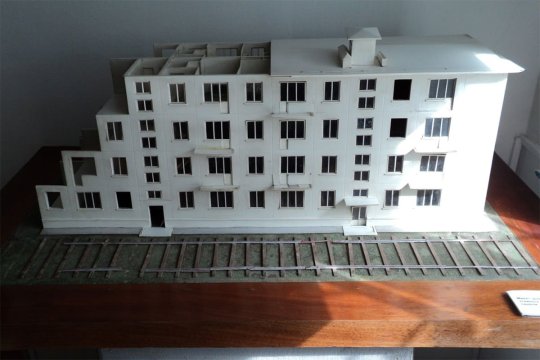
Strelka Mag. 2018. Khruschyovka Museum: How A Soviet Block Of Flats Is Getting Immortalized In Moscow. [online] Available at: https://strelkamag.com/ru/article/muzei-khrushyovki-kak-v-moskve-pytayutsya-uvekovechit-sovetskuyu-pyatietazhku [Accessed 21 April 2020].
The article above follows the creation of a khruschyovka museum in Moscow. The process turned out to be rather complex, as the city’s officials initially refused the idea and demolished the buildings that the museum was expected to be in. However, seemingly the idea is still in development. The plan is to recreate the flats of famous actors or musicians, such as Vysotsky, in a khruschyovka, making the flats an exhibition space.
The idea was interesting to me, because the thought of creating an exhibition in a khruschyovka is so contrasting with how it is commonly viewed, and how it was created -- simplistic, cheap and easy to build, temporary housing. It is interesting to think how these buildings are going to be seen in 30 or 50 years from now, and whether any of them will remain at all. Will they be treated as a disappearing part of our heritage that needs to be protected? Will the government keep demolishing them all?
Keywords: accommodation, Russian culture, personal attachment, exhibition space
0 notes